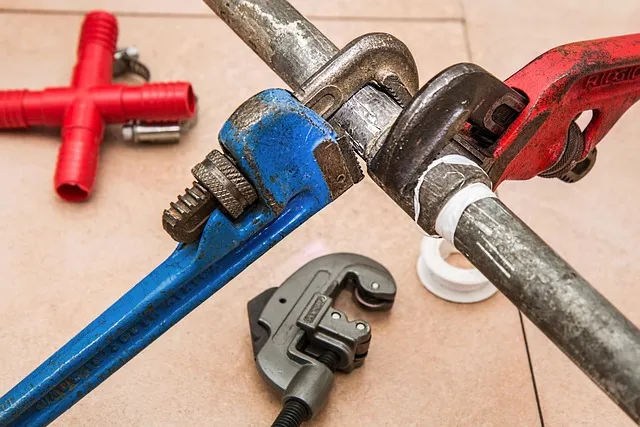Concrete crack repair involves assessing damage, identifying causes (e.g., temperature fluctuations, structural issues), and choosing appropriate methods like surface patching or injection molding. Key steps include thorough cleaning, using durable materials like epoxy/polyurethane fillers to completely fill cracks, and ensuring proper curing for long-lasting repairs that extend concrete structure lifespans by up to 30 years. Regular maintenance, including inspections and sealing, is crucial to prevent crack formation and costly repairs.
“Concrete cracks, a common sight in structures across various industries, can range from minor aesthetics to major structural issues. Understanding these cracks, their causes, and types is crucial for effective professional crack repair. This comprehensive guide delves into the intricacies of concrete crack assessment, repair techniques, material selection, and step-by-step processes. By avoiding common mistakes and implementing maintenance tips, professionals ensure long-lasting durability. From inspection to prevention, this article equips readers with essential knowledge for efficient crack repair.”
Understanding Concrete Cracks: Causes and Types

Concrete cracks can range from subtle hairline fractures to large, visible splits, each with its own unique cause and type. Understanding these variations is crucial for effective crack repair. The most common causes include movement and stress due to changes in temperature and moisture levels, structural issues like poor initial concrete quality or improper construction, and environmental factors such as heavy traffic loads or chemical attacks.
There are several types of cracks: hairline cracks are thin, shallow, and often result from early-stage drying shrinkage; diagonal cracks appear at angles and usually indicate tensile stress; vertical cracks develop due to differential settling or load bearing; and random, irregular cracks may signal underlying structural problems. Accurately identifying the type and cause of a crack is essential for selecting the appropriate crack repair method, whether it’s surface patching, injection molding, or more extensive structural reinforcement.
Assessment: Inspecting Damage Extent

When addressing concrete repair, the first step is a thorough assessment to determine the extent of the damage. This involves closely inspecting the surface for cracks, which can vary in size, shape, and depth. Cracks are not only unsightly but also indicative of potential structural issues that require prompt attention.
The assessment should also consider the cause behind these cracks, such as settling, shifting soil, or age-related deterioration. Proper crack repair involves addressing the root cause to prevent further damage. This meticulous process ensures that any repairs are effective and long-lasting, contributing to the overall longevity of the concrete structure.
Crack Repair Techniques: A Comprehensive Overview

Concrete structures, over time, are prone to developing cracks due to various factors like aging, weather conditions, and structural stress. Efficient crack repair is essential for maintaining the integrity and longevity of concrete surfaces. There are several techniques employed in professional concrete repair to address these cracks effectively.
The most common approach involves using specialized epoxy or polyurethane injections to fill and strengthen the cracks from within. This method provides excellent resistance against further damage and offers a durable solution. Surface patching is another technique, where ready-mixed concrete or mortar is used to fill small to medium-sized cracks, restoring the surface’s smoothness and structural stability. For larger cracks, structural repair methods are implemented, including steel reinforcement and advanced polymeric patching compounds, ensuring the concrete can bear heavy loads again.
Choosing the Right Materials for Durability

When it comes to professional concrete repair, selecting the appropriate materials is paramount for achieving long-lasting results, especially in crack repair. The durability of the fix depends on using high-quality products designed to withstand environmental factors like sun, rain, and frost. Concrete is a robust material, but over time, cracks can form due to various stresses, requiring effective repairs to maintain structural integrity.
For successful crack repair, professionals often opt for specialized epoxy or polyurethane-based fillers. These materials offer excellent adhesion, flexibility, and resistance to moisture penetration, ensuring the cracks don’t re-open. The right choice depends on the severity of the damage and the specific conditions at the repair site. Using the correct products will guarantee that the concrete surface remains strong and stable for years to come.
Step-by-Step Guide to Efficient Crack Repair

Crack repair is a crucial aspect of maintaining and preserving concrete structures, whether it’s a driveway, sidewalk, or industrial floor. A well-executed crack repair can extend the lifespan of these surfaces significantly. Here’s a step-by-step guide to efficiently repairing cracks in concrete.
First, assess the severity of the crack using appropriate tools and techniques. This involves measuring its width, depth, and length. Once evaluated, prepare the crack by cleaning it thoroughly to remove any debris or loose concrete. This can be done manually or with specialized equipment like high-pressure washers. After cleaning, apply a suitable epoxy or polymer-based filler designed for crack repair. Fill the crack completely, ensuring no gaps exist. Finally, smoothen the surface and allow the filler to cure as per the manufacturer’s instructions for optimal results.
Common Mistakes to Avoid During the Process

Concrete is a durable material, but it’s not invincible. Over time, cracks can develop due to various factors like settlement, moisture, or environmental stress. When addressing crack repair, professionals often encounter mistakes that can compromise the long-term integrity of the structure. One of the most common blunders is ignoring the root cause of the crack. Simply patching over active cracks without identifying and addressing underlying issues can lead to repeated repairs. Another frequent mistake is using the wrong type of sealant or filler for the specific crack size and depth, which may result in poor bonding and accelerated degradation.
Proper preparation is key to successful crack repair. Failing to clean and prepare the concrete surface adequately before applying a patch can hinder adhesion and cause future issues. Additionally, skimping on materials or using low-quality products might seem like a cost-saver initially but often leads to more extensive repairs down the line. Always follow manufacturer guidelines for product application and curing times.
Maintenance Tips for Longevity and Prevention

Regular maintenance is key to extending the lifespan of concrete structures and preventing costly repairs, especially in crack repair. One of the most effective preventive measures is frequent inspection, allowing for early detection of any cracks or signs of damage. This proactive approach enables property owners and managers to address issues before they escalate.
Simple yet crucial maintenance tasks include sealing new concrete to prevent water penetration, which can lead to erosion and cracking. Additionally, applying a regular coat of sealer to existing surfaces helps protect against the elements. Crack repair should not be postponed; small cracks can quickly widen, causing structural integrity issues. Prompt attention to these fractures ensures longevity and prevents further damage.
